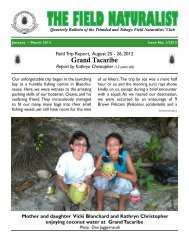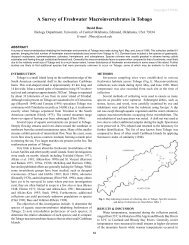Vol 2 - The Trinidad and Tobago Field Naturalists' Club
Vol 2 - The Trinidad and Tobago Field Naturalists' Club
Vol 2 - The Trinidad and Tobago Field Naturalists' Club
Create successful ePaper yourself
Turn your PDF publications into a flip-book with our unique Google optimized e-Paper software.
THE FIELD NATURALISTFIELD TRIP REPORTSt Ann’s – January 30, 2005John Lum YoungAt the trail briefing we learnt that the walk comprised two sections: initially to the Fondes Am<strong>and</strong>es Road ReafforestationProject, the first self-help reafforestation project in the country to become a model for other communities; then to thesummit of St Ann’s Peak.Akeella Jaramugee’s husb<strong>and</strong> started squatting in 1982 on l<strong>and</strong>s belonging to WASA in the Fondes Am<strong>and</strong>es watercatchment. Mr. Jaramugee soon realised that “slash <strong>and</strong> burn” agriculture yielded less <strong>and</strong> less, <strong>and</strong> the annual fires to clear thel<strong>and</strong> for planting had many disadvantages including loss of valuable moisture in the Dry Season <strong>and</strong> loss of the scant top soilin the Rainy Season leading to clogging of waterways <strong>and</strong> flooding of the communities down slope. He saw the slopes changefrom forest cover to grass fire climax.He thus decided to educate himself <strong>and</strong> other squatters who learned more sustainable techniques for managing thehillsides. <strong>The</strong>y cut fire traces, made drains across the slopes, built small check dams to slow the speed with which the waterdescended to the village, planted trees like Acacia (Acacia mangium) that were able to grow in a fire zone <strong>and</strong> grass likeVetiver (Vetiveria zizanioides) with its tufted perennial roots forming large compact tussocks to hold the soil. Of course theypatrolled the hills in the Dry Season to keep out fire setters <strong>and</strong> beat out fires. After his death in 1994 Akeella continued thehard work. With the vigilance maintained there has not been a bush fire since 2001. Some of the internal fire traces were replantedwith Mountain Berry (Mabea Occidentalis), Pommerac (Eugenia malaccensis), Cedar (Cedrela odorata) <strong>and</strong> Mahogany(Swietenia macrophylla) <strong>and</strong> the Acacia was replaced. Mountain Berry, indigenous to the drier western Northern Range,reaches a height of 16 ft. <strong>and</strong> forms thick groves. (We enjoyed the shade of one such grove that fortunately survived the repeatedfires of past years.) Fire traces still need to be maintained in the cropping areas <strong>and</strong> to keep out fires climbing over fromMaraval Valley. <strong>The</strong> project covered 80 acres.We were also introduced to John Stollmeyer who provided ongoing technical advice to Akeella. John believed thatthe best way to protect biodiversity was to save one’s immediate environment with the flora <strong>and</strong> fauna native to that locale.Not only had the greenery returned but the wildlife also, among them squirrel, agouti, iguana, birds <strong>and</strong> butterflies.Perched above in thick foliage was the Spectacled Owl (Pulsatrix perspicillata trinitatis) our largest owl at 18 inches. Thoughthe P. perspicillata range from Mexico to Argentina the <strong>Trinidad</strong> owl has paler buff underparts <strong>and</strong> is a sub-species only recordedon this isl<strong>and</strong>. P. p. trinitatis, found in dry lowl<strong>and</strong> forest, cultivated areas <strong>and</strong> rain forest up to 2000 ft., can be describedas uncommon. It eats most small mammals, birds, frogs, lizards, grasshoppers <strong>and</strong> caterpillars. <strong>The</strong> dark brown patcharound the eyes with superciliary, whitish stripe meeting between eyes <strong>and</strong> prolonged from base of bill below eyes gives the“spectacled” effect.A Queen Cracker Butterfly (Hamadryas arethusa) was spotted on the trunk of a tree in its st<strong>and</strong>ard position facingdownwards. It is not known why all the butterflies in this species face downwards. Some speculate that it is for easy take off,others for protection, but no one really knows. <strong>The</strong> Cracker butterflies are so named because of the crackling sound madewhen they flutter about. Exactly how the sound is produced is also unknown.On the ridge that separated Fondes Am<strong>and</strong>es from the north St. Ann’s Valley the group split, with the more adventurousaiming for St. Ann’s Peak <strong>and</strong> the others continuing the tour of the project. Reg Potter warned that the trail was little used<strong>and</strong> the bush fires over the years meant that razor grass ruled the open sections. This did not deter the dozen or so who werekeen to attempt the Peak.We climbed the ridge to meet the trail from Lady Chancellor Road which hugged the mountainside just below the top<strong>and</strong> provided excellent views of Port of Spain, Caroni Swamp, Hololo <strong>and</strong> lower St Ann’s Valley. This was the furthest endfrom which to tackle St. Ann’s Peak. Walking from Hololo or Santa Cruz was shorter, the Peak being only about 2 miles fro mMorvant.It was a decent bench trail once the canopy was intact. In areas of bright sunlight (as a result of tree falls, l<strong>and</strong>slips<strong>and</strong> fires) razor grass <strong>and</strong> shrubs were thick <strong>and</strong> the trail had to be reopened. This slowed us considerably <strong>and</strong> we wonderedwhen the group would have enough <strong>and</strong> decide to turn back. Bloodwood (Croton gossypiifolius), a medium sized tree that wasquick to establish itself in open spaces, was regularly seen along the trail. Like most plants, it was in flower with the advent ofthe Dry Season <strong>and</strong> its characteristic long inflorescence was very noticeable.We rounded a spur of the mountain <strong>and</strong> had a panoramic view of the St. Ann’s Valley head. It was now after 12 noon<strong>and</strong> there was still some distance to even see the Peak which was being blocked by a spur off Hololo.In the forest below, Immortelle in bloom dotted the l<strong>and</strong>scape with spots of bright orange. Cypre (Cordia alliodora)was also in flower. Related to Black Sage, Cypre was a fairly large tree sometimes over 100 ft. in height <strong>and</strong> 10 ft. in girth. Itpreferred the drier hilly forests <strong>and</strong> so could be found in the Bocas Isl<strong>and</strong>s, the Southern Watershed <strong>and</strong> western NorthernRange. C. alliodora was rarely seen on flat l<strong>and</strong>. <strong>The</strong> Rainy Season was a time of profuse growth for most plants but, uncommonly,this plant sheds all its leaves in the Wet Season. <strong>The</strong> small fruits of the Cypre were eaten by birds such as Scaled Pigeon,parrots <strong>and</strong> doves. Cypre was a popular furniture wood of choice in the 60s before the advent of modern “fast” furniture.3








